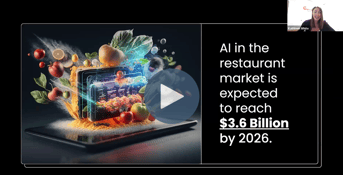Updated July 31, 2025
The long road to teaching machines to do kitchen work really makes you appreciate a good fry cook. It turns out that the jobs we’ve entrusted to food service staffers are more complex than they might first appear. An entire branch of industrial robotic technology is spending millions to develop gadgets that can do the work of a single distracted 20-year-old fast-food assistant manager.
As robotics companies gradually automate some of the more rote tasks of restaurant work — delivering food to tables, for instance, or making sure burgers are cooked all the way through — they’re taking pressure off restaurant operators to hire workers in a tight job market.
As anyone who placed a want ad for line cooks or bartenders in the past two years knows, applicants are way down, and candidates who actually show for the interviews are even lower. It’s no coincidence that in a time of $500 McDonald’s signing bonuses, we’re talking about robots taking on more of the workload of serving food.
But the roles of robots in restaurants go beyond the tasks that your existing staff handles. Some of the pioneering companies in this space have adapted robotics to expand what’s possible for a vending machine or coffee stand or ghost kitchen. Read on to get a survey of the latest in the field of robotic food and drink solutions.
Miso Robotics
Since it introduced a burger-cooking robot named Flippy in 2017, Miso Robotics has pioneered kitchen automation like few other companies in the world. The Pasadena, California-based startup is creating robots that take on repetitive, menial, risky kitchen jobs.
White Castle and now Jack in the Box use Flippy and its second-gen version Flippy 2 to whip up burgers and handle french fry duties. Chipotle took Miso’s Flippy Lite and assigned it tortilla chip prep work; Buffalo Wild Wings adapted it for chicken wing prep.
Miso has also broken out the temperature monitoring system from Flippy and sells it as CookRight, a companion for humans to monitor up to 50 food items on a grill or as its own coffee-stand-monitoring system that tracks temperatures and levels of coffee urns. It’s an impressive array of products built around the key fundamentals of monitoring time, temperature, and doneness of food and drink.
Presto
While some companies focus on delivery robots that bring plates to tables, Presto has gone full Star Trek with its vision: voice assistants, computer vision, and artificial intelligence that transform how restaurants operate — all while keeping the human touch intact.
Based in Silicon Valley, Presto started with tabletop tablets that let guests order, pay, and play games without flagging down a server. But these days, the company is taking things several steps further. We’re talking voice AI that can take drive-thru orders with eerily good accuracy, computer vision systems that monitor kitchen and dining area activity in real-time, and analytics that help operators fine-tune every part of the customer experience.
Think of Presto as the brains behind the scenes, quietly replacing clunky old POS systems and phone-based ordering with automation that actually makes life easier for staff and smoother for guests. Food chains like Applebee's, Checkers, and Del Taco are already on board — and not just because it looks good on TikTok. In the restaurant industry, where timing, labor, and data can make or break a restaurant, Presto is helping brands get a whole lot smarter, without needing a tech degree.
Kitchen Robotics
Kitchen Robotics isn’t automating just one kitchen task, but entire kitchens — or as they call it, robotic dark kitchen solutions. A robot called a “Beastro” can prep and even deliver dishes in as many different cuisines as you program, letting you run a virtual kitchen concept remotely.


Subscribe to Our Monthly Operations Newsletter
Learn how to streamline your processes, cut costs, and run a more efficient restaurant.
Picture this: a sleek stainless steel wall lined with tubes, each one filled with ready-to-go ingredients — think chopped veggies, cooked pasta, and all kinds of tasty extras. An automated pot taps into these tubes and grabs what it needs, plus the right dressing or sauce, all based on a programmed recipe. Then it glides over to a row of tilted burners, where it heats up and gently spins, letting gravity do the stirring for you.
It’s a perfect fast-casual kitchen rig for someone who needs speed, consistency, and connectivity to execute their concept.
True Bird
Automated coffee systems may conjure memories of overnight stays in hospitals or endless delays at a bus station — the sort of situations in which you will literally drink any thin sludge named coffee, out of sheer desperation. True Bird is blowing up that image.
The startup has teamed with craft coffee roasters in New York City to brew at an automated, 20-foot-long kiosk it calls a “fully automated micro-cafe.” The setup resembles something you might expect to see at a Scandinavian airport, and presumably delivers a cuppa joe that blows away the last vending coffee you bought.
Bear Robotics
San Francisco-based Bear Robotics was among the first companies that brought robots to the front of the house. Its low-profile “Servi” — imagine a machine that looks like a plastic shelf riding a Roomba — has handled tasks like drink and food delivery as well as bussing tables for restaurants and hospitality brands like Chili’s, Denny’s, and Marriott.
It may not be as sexy as robot arms that brave hot grease or robotic kitchens that work like a line cook, but it lightens menial tasks for restaurant staffs who’d rather be doing more interesting stuff.
Xrobotics
Whipping up pies fast is the name of the game for Xrobotics. The San Francisco company has released a variety of pizza-making bots that inspire comparisons to 3D printers. Its flagship, the xPizza Cube, is built as a time-saving countertop device for pizza parlors.
You put tossed dough onto a platform that spins below a device that layers ingredients onto the pie. The machine needs only about one minute to add sauce, cheese, and pepperoni to a pie, freeing time for your staff to focus on tossing dough, baking the pies, and handling orders.
Dexai Robotics
Started by MIT graduates, Boston-based Dexai Robotics has already unveiled its first product, a robotic sous chef named "Alfred" capable of carrying out tasks from scooping ice cream to assembling a poke bowl. Users control the robot through a tablet interface, providing an easy path to things like making recipe updates or analyzing performance.
While Alfred has mostly seen application in larger commercial kitchens thus far, expect to see him lining up more and more restaurant "sous chef" gigs in the future.
Hyper Food Robotics
Started by the former CEO of Domino's Pizza Israel, Hyper Food Robotics launched with a prototype the size of a 40-foot shipping container that can create 50 pizzas in an hour.
The autonomous restaurant model uses a pair of robotic arms along with 120 sensors and 20 AI-powered cameras to create pie after pie from a menu that can support as many as four kinds of dough and eight toppings, as well as several side dishes. Take a look at our Q&A with the founder for more on how they're planning to claim their piece of the pizza industry.
See How the Latest Tech Can Transform Your Restaurant
There’s no shortage of shiny new tools in the restaurant tech world. But which ones actually make sense for your business? Back of House is your guide to cutting through the noise.
Book a call today to talk with one of our experts to get personalized guidance on the right solutions for your needs. Whether you're upgrading your POS, managing staffing more efficiently, streamlining operations, or looking to boost guest engagement, we'll help you cut through the noise and connect with vendors that make sense for you.





